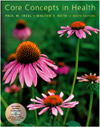Paul M. Insel,
Stanford University School of Medicine
Walton T. Roth,
Stanford University School of Medicine
| intentional injury | An injury that is purposely inflicted, by either oneself or another person.
|
 |
 |
 |
| unintentional injury | An injury that occurs without harm being intended.
|
 |
 |
 |
| years of potential life lost | The difference between an individual's life expectancy and his or her age at death.
|
 |
 |
 |
| motor vehicle injuries | Unintentional injuries and deaths involving motor vehicles in motion, both on and off the highway or street; incidents causing motor vehicle injuries include collisions between vehicles and collisions with objects or pedestrians.
|
 |
 |
 |
| home injuries | Unintentional injuries and deaths that occur in the home and on home premises to occupants, guests, domestic servants, and trespassers; falls, burns, poisonings, suffocations, unintentional shootings, drownings, and electrical shocks are examples.
|
 |
 |
 |
| Heimlich maneuver | A maneuver developed by Henry J. Heimlich, M.D., to help force an obstruction from the airway.
|
 |
 |
 |
| leisure injuries | Unintentional injuries and deaths that occur in public places or places used in a public way, not involving motor vehicles; includes most sports and recreation deaths and injuries; falls, drownings, burns, and heat and cold stress are examples.
|
 |
 |
 |
| personal flotation device (PFD) | A device designed to save a person from drowning by buoying up the body while in the water; also called a life jacket.
|
 |
 |
 |
| work injuries | Unintentional injuries and deaths that arise out of and in the course of gainful work, such as falls, electrical shocks, exposure to radiation and toxic chemicals, burns, cuts, back sprains, and loss of fingers or other body parts in machines.
|
 |
 |
 |
| repetitive-strain injury (RSI) | A musculoskeletal injury or disorder caused by repeated strain to the hand, arm, wrist, or other part of the body; also called cumulative trauma disorder (CTD).
|
 |
 |
 |
| carpal tunnel syndrome | Compression of the median nerve in the wrist, often caused by repetitive use of the hands, such as in computer use; characterized by numbness, tingling, and pain in the hands and fingers; can cause nerve damage.
|
 |
 |
 |
| sexual assault or rape | The use of force to have sex with someone against that person's will.
|
 |
 |
 |
| statutory rape | Sexual interaction with someone under the legal age of consent.
|
 |
 |
 |
| date rape | Sexual assault by someone the victim knows or is dating; also called acquaintance rape.
|
 |
 |
 |
| incest | Sexual activity between close relatives, such as siblings or parents and their children.
|
 |
 |
 |
| sexual harassment | Unwelcome sexual advances, requests for sexual favors, and other conduct of a sexual nature that affects academic or employment decisions or evaluations; interferes with an individual's academic or work performance; or creates an intimidating, hostile, or offensive academic, work, or student living environment.
|
 |
 |
 |
| first aid | Emergency care given to an ill or injured person until medical care can be obtained.
|
 |
 |
 |
| cardiopulmonary resuscitation (CPR) | An emergency first aid procedure that combines artificial respiration and artificial circulation; used in first aid emergencies where breathing and blood circulation have stopped.
|
 |
 |
 |
| emergency medical services (EMS) system | A system designed to network community resources for providing emergency care.
|
 |
 |
 |
| stalking | Repeatedly harassing or threatening a person through behaviors such as following a person, appearing at a person's residence or workplace, leaving written messages or objects, making harassing phone calls, or vandalizing property; frequently directed at a former intimate partner.
|
 |
 |
 |
| cyberstalking | The use of e-mail, chat rooms, bulletin boards, or other electronic communications devices to stalk another person.
|



 2002 McGraw-Hill Higher Education
2002 McGraw-Hill Higher Education